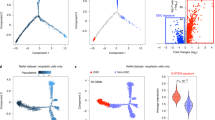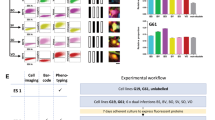Abstract
Glioblastomas (GBMs) contain transformed, self-maintaining, multipotent, tumour-initiating cancer stem cells, whose identification has radically changed our perspective on the physiology of these tumours. Currently, it is unknown whether multiple types of transformed precursors, which display alternative sets of the complement of properties of true cancer stem cells, can be found in a GBM. If different subsets of such cancer stem-like cells (CSCs) do exist, they might represent distinct cell targets, with a differential therapeutic importance, also depending on their characteristics and lineage relationship. Here, we report the presence of two types of CSCs within different regions of the same human GBM. Cytogenetic and molecular analysis shows that the two types of CSCs bear quite diverse tumorigenic potential and distinct genetic anomalies, and, yet, derive from common ancestor cells. This provides critical information to unravel the development of CSCs and the key molecular/genetic components underpinning tumorigenicity in human GBMs.
This is a preview of subscription content, access via your institution
Access options
Subscribe to this journal
Receive 50 print issues and online access
$259.00 per year
only $5.18 per issue
Buy this article
- Purchase on Springer Link
- Instant access to full article PDF
Prices may be subject to local taxes which are calculated during checkout


Similar content being viewed by others
References
Ailles LE, Weissman IL . (2007). Cancer stem cells in solid tumors. Curr Opin Biotechnol 18: 460–466.
Beier D, Hau P, Proescholdt M, Lohmeier A, Wischhusen J, Oefner PJ et al. (2007). CD133(+) and CD133(−) glioblastoma-derived cancer stem cells show differential growth characteristics and molecular profiles. Cancer Res 67: 4010–4015.
Galli R, Binda E, Orfanelli U, Cipelletti B, Gritti A, De Vitis S et al. (2004). Isolation and characterization of tumorigenic, stem-like neural precursors from human glioblastoma. Cancer Res 64: 7011–7021.
Gunther HS, Schmidt NO, Phillips HS, Kemming D, Kharbanda S, Soriano R et al. (2008). Glioblastoma-derived stem cell-enriched cultures form distinct subgroups according to molecular and phenotypic criteria. Oncogene 27: 2897–2909.
Joo KM, Kim SY, Jin X, Song SY, Kong DS, Lee JI et al. (2008). Clinical and biological implications of CD133-positive and CD133-negative cells in glioblastomas. Lab Invest 88: 808–815.
Ogden AT, Waziri AE, Lochhead RA, Fusco D, Lopez K, Ellis JA et al. (2008). Identification of A2B5+CD133− tumor-initiating cells in adult human gliomas. Neurosurgery 62: 505–514 (discussion 514–5).
Piccirillo SG, Reynolds BA, Zanetti N, Lamorte G, Binda E, Broggi G et al. (2006). Bone morphogenetic proteins inhibit the tumorigenic potential of human brain tumour-initiating cells. Nature 444: 761–765.
Piccirillo SG, Vescovi AL . (2007). Brain tumour stem cells: possibilities of new therapeutic strategies. Expert Opin Biol Ther 7: 1129–1135.
Reya T, Morrison SJ, Clarke MF, Weissman IL . (2001). Stem cells, cancer, and cancer stem cells. Nature 414: 105–111.
Reynolds BA, Rietze RL . (2005). Neural stem cells and neurospheres—re-evaluating the relationship. Nat Methods 2: 333–336.
Singh SK, Hawkins C, Clarke ID, Squire JA, Bayani J, Hide T et al. (2004). Identification of human brain tumour initiating cells. Nature 432: 396–401.
Trent S, Kong A, Short SC, Traish D, Ashley S, Dowe A et al. (2002). Temozolomide as second-line chemotherapy for relapsed gliomas. J Neurooncol 57: 247–251.
Vescovi AL, Galli R, Reynolds BA . (2006). Brain tumour stem cells. Nat Rev Cancer 6: 425–436.
Wang J, Sakariassen PO, Tsinkalovsky O, Immervoll H, Boe SO, Svendsen A et al. (2008). CD133 negative glioma cells form tumors in nude rats and give rise to CD133 positive cells. Int J Cancer 122: 761–768.
Acknowledgements
This work was supported by grants of the ‘Associazione Italiana per la Ricerca Sul Cancro’ AIRC, Italy and the Brain Tumor Funders Collaborative Initiative, USA.
Author information
Authors and Affiliations
Corresponding authors
Additional information
Supplementary Information accompanies the paper on the Oncogene website (http://www.nature.com/onc)
Rights and permissions
About this article
Cite this article
Piccirillo, S., Combi, R., Cajola, L. et al. Distinct pools of cancer stem-like cells coexist within human glioblastomas and display different tumorigenicity and independent genomic evolution. Oncogene 28, 1807–1811 (2009). https://doi.org/10.1038/onc.2009.27
Received:
Revised:
Accepted:
Published:
Issue Date:
DOI: https://doi.org/10.1038/onc.2009.27
Keywords
This article is cited by
-
Advances in histone deacetylase inhibitors in targeting glioblastoma stem cells
Cancer Chemotherapy and Pharmacology (2020)
-
Widely metastatic IDH1-mutant glioblastoma with oligodendroglial features and atypical molecular findings: a case report and review of current challenges in molecular diagnostics
Diagnostic Pathology (2019)
-
Levetiracetam enhances the temozolomide effect on glioblastoma stem cell proliferation and apoptosis
Cancer Cell International (2018)
-
Glioblastoma niches: from the concept to the phenotypical reality
Neurological Sciences (2018)
-
Changes in chromatin state reveal ARNT2 at a node of a tumorigenic transcription factor signature driving glioblastoma cell aggressiveness
Acta Neuropathologica (2018)



